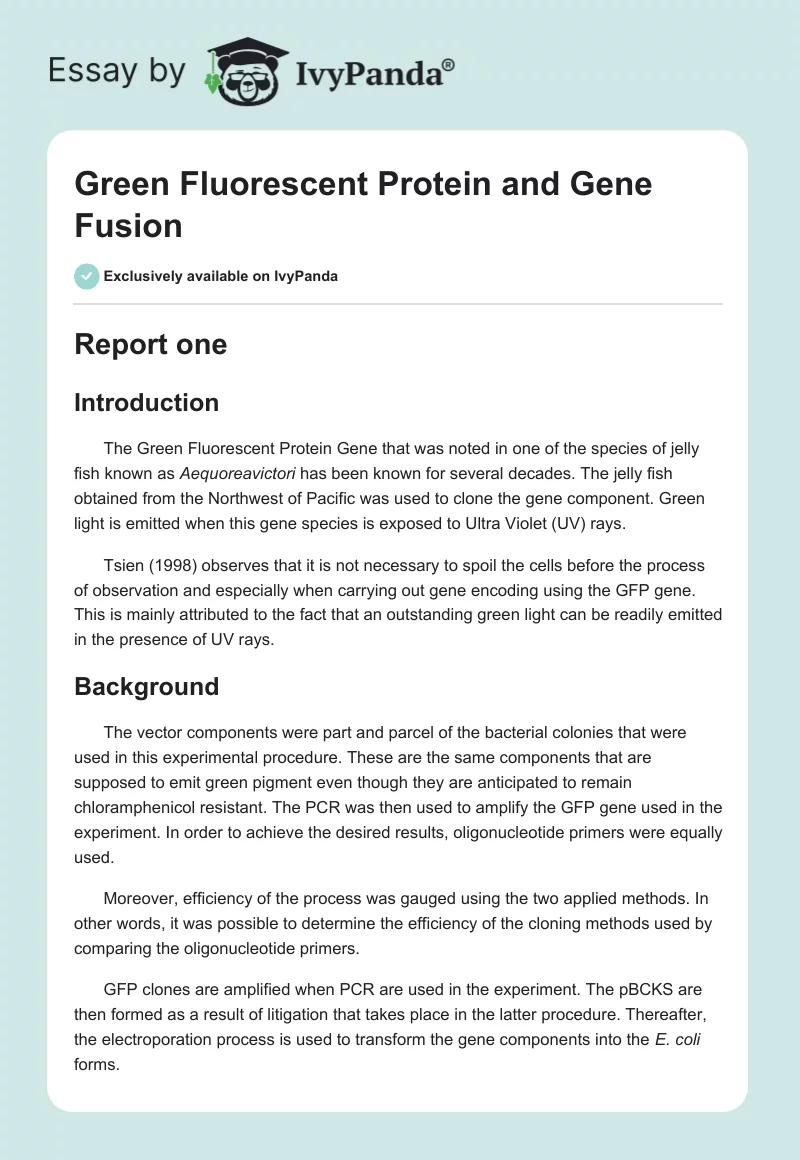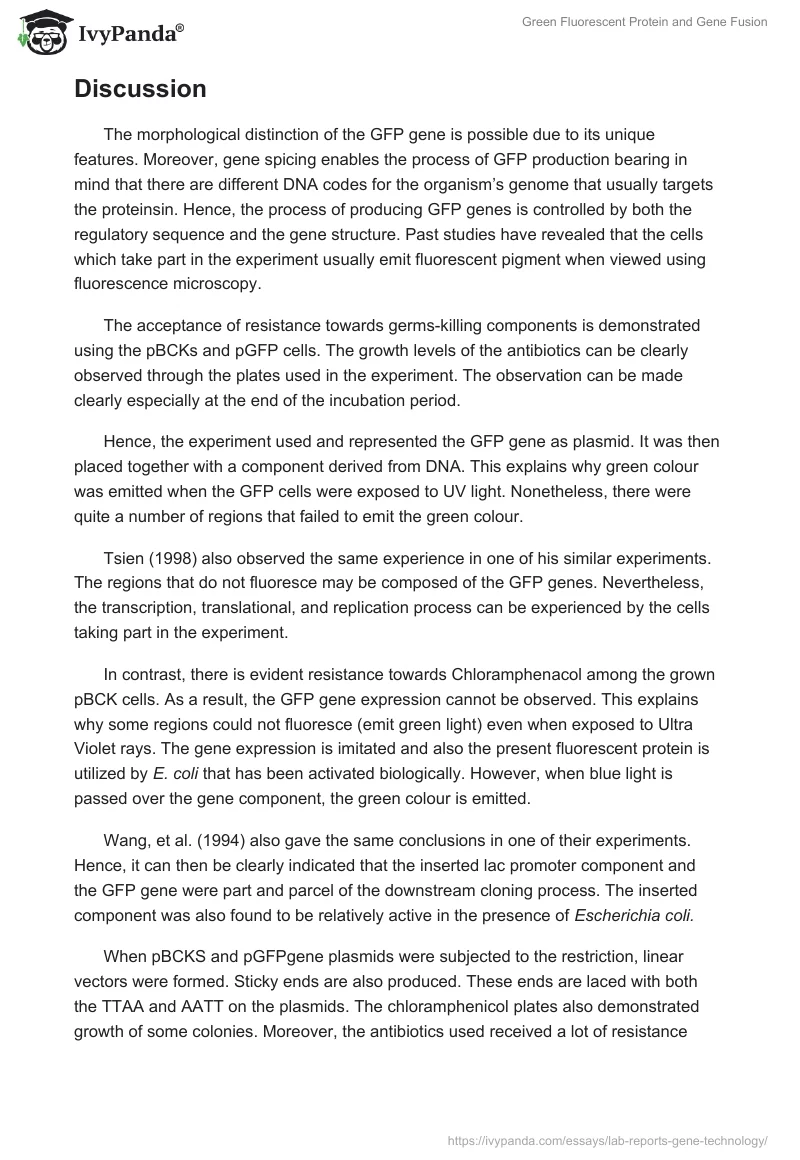Report one
Introduction
The Green Fluorescent Protein Gene that was noted in one of the species of jelly fish known as Aequoreavictori has been known for several decades. The jelly fish obtained from the Northwest of Pacific was used to clone the gene component. Green light is emitted when this gene species is exposed to Ultra Violet (UV) rays.
Tsien (1998) observes that it is not necessary to spoil the cells before the process of observation and especially when carrying out gene encoding using the GFP gene. This is mainly attributed to the fact that an outstanding green light can be readily emitted in the presence of UV rays.
Background
The vector components were part and parcel of the bacterial colonies that were used in this experimental procedure. These are the same components that are supposed to emit green pigment even though they are anticipated to remain chloramphenicol resistant. The PCR was then used to amplify the GFP gene used in the experiment. In order to achieve the desired results, oligonucleotide primers were equally used.
Moreover, efficiency of the process was gauged using the two applied methods. In other words, it was possible to determine the efficiency of the cloning methods used by comparing the oligonucleotide primers.
GFP clones are amplified when PCR are used in the experiment. The pBCKS are then formed as a result of litigation that takes place in the latter procedure. Thereafter, the electroporation process is used to transform the gene components into the E. coli forms.
Discussion
The morphological distinction of the GFP gene is possible due to its unique features. Moreover, gene spicing enables the process of GFP production bearing in mind that there are different DNA codes for the organism’s genome that usually targets the proteinsin. Hence, the process of producing GFP genes is controlled by both the regulatory sequence and the gene structure. Past studies have revealed that the cells which take part in the experiment usually emit fluorescent pigment when viewed using fluorescence microscopy.
The acceptance of resistance towards germs-killing components is demonstrated using the pBCKs and pGFP cells. The growth levels of the antibiotics can be clearly observed through the plates used in the experiment. The observation can be made clearly especially at the end of the incubation period.
Hence, the experiment used and represented the GFP gene as plasmid. It was then placed together with a component derived from DNA. This explains why green colour was emitted when the GFP cells were exposed to UV light. Nonetheless, there were quite a number of regions that failed to emit the green colour.
Tsien (1998) also observed the same experience in one of his similar experiments. The regions that do not fluoresce may be composed of the GFP genes. Nevertheless, the transcription, translational, and replication process can be experienced by the cells taking part in the experiment.
In contrast, there is evident resistance towards Chloramphenacol among the grown pBCK cells. As a result, the GFP gene expression cannot be observed. This explains why some regions could not fluoresce (emit green light) even when exposed to Ultra Violet rays. The gene expression is imitated and also the present fluorescent protein is utilized by E. coli that has been activated biologically. However, when blue light is passed over the gene component, the green colour is emitted.
Wang, et al. (1994) also gave the same conclusions in one of their experiments. Hence, it can then be clearly indicated that the inserted lac promoter component and the GFP gene were part and parcel of the downstream cloning process. The inserted component was also found to be relatively active in the presence of Escherichia coli.
When pBCKS and pGFPgene plasmids were subjected to the restriction, linear vectors were formed. Sticky ends are also produced. These ends are laced with both the TTAA and AATT on the plasmids. The chloramphenicol plates also demonstrated growth of some colonies. Moreover, the antibiotics used received a lot of resistance from the cells used in the experiment. Fluorescent was not produced even after exposure to UV rays.
Hence, it indicated that the litigation reaction had failed or become impaired. From the experimental results, it was evident that when the pGFP plasmid was used in the sub cloning process, the process did not succeed. This was mainly occasioned by the fact that there was partial digestion process or the system was inactive.
Report two
Introduction
The field of medicine has immensely benefited from the process of protein localization in E. coli using Green Fluorescent Protein (GFP). One of the areas of concerns has been the development of gene fusions. Two main components used in this process have been the variant of gfp and malE [MBP]. The GFPuv has also been optimized using the latter components. The hybrid proteins used to be encoded using GFP combined with carboxy-terminal end.
Background
The -galactosidase expression is induced using IPTG in the lac promoter region. When this component is used, the involved gene sequence and the performance of the transcription are significantly improved. The BioRad dye binding assay is also used to estimate various quantities of protein components used in the experiment.
The process is carried out using specific time intervals. According to this experiment, both the GFP protein and the protein components that were used work in a similar manner. The reagents are then applied with the Gel electrophoresis in order to identify the proteins taking part in the experiment. Hence, its main role is to monitor the levels at which protein quantities are increasing. It is also instrumental in determining the concentration levels of GFP proteins that are present in the induced cultures.
Discussion
In order to express GFP, the recombinant E. coli can be used in a unique manner. In this case, it is applied as a gene product model component for investigating various conditions in organisms. Cha et al. (2000) is quite categorical that when making use of GFP, a gene in a specific organism can be easily expressed.
Moreover, it is possible for the system of an organism to be introduced with the component. It can equally be integrated in the genome system especially through viral vector injection, cell transformation and also when carrying out breeding process.
In this experiment, colour change was the main guiding factor for correlating concentration and the level of protein assayed component. The color changes were compared with 595 nm. When proteins are absent, the results are blank and the indicator shows a zero mark. When a linear equation y = 0.16x + 0.36 is used, it is possible to obtain the level of concentration of the unknown protein samples. From the results, a standard curve was drawn to indicate the various levels of protein concentration.
The results indicated that the GFP concentration was high at 0.5ug/ul. Moreover, there was a remarkable content expression when the protein sample was induced at 0 hours. This was mainly attributed by the either the background expression or basal expression. This finding is also supported by research studies conducted by Tsien (1998).
According to this experimental result, the GFP components that are identical to the protein expressions have been facilitated by the E coli component. When optimal expression is analyzed, the best operating conditions were not considered as the 3 hours that were taken and the lac promoter used. In fact, the contents of the lac promoter affected the final results.
The E coli activities also affected the components of the GFP gene during the process of downstream cloning. Kosinski, Rinas and Bailey (1992) reiterate that when E coli strain is combined with IPTG, it agitates the rate of growth of any given protein. However, the procedure ought to be carried out when lac promoter is present.
The electrophoresis processes with the assistance of SDS gel were used to demonstrate the expressed protein purity. Protein bands that were almost same in size were also visualized. The GFP protein size was also demonstrated by the fact that the sizes ranged between 27 and 30 KDa. However, Burnette (1981) notes that the migration rates affect these sizes. Besides, the binding dye effects affected the clarity of the final outcomes.
According to Burnette (1981), the generation of coloured precipitates is affected by the primary antibodies. The precipitation levels are also affected when the subsrate are added. Clear bands were seen at 30KDa since the dye bound well with the GFP protein components


